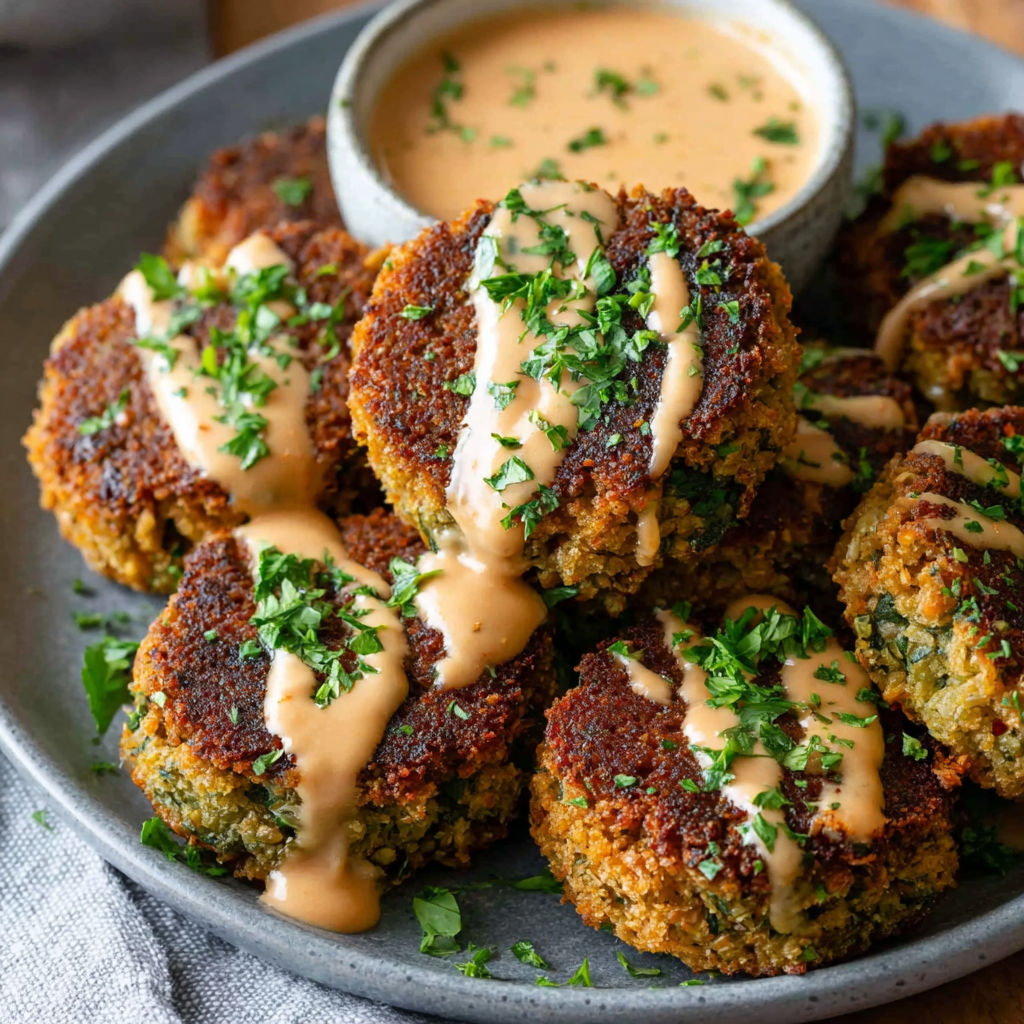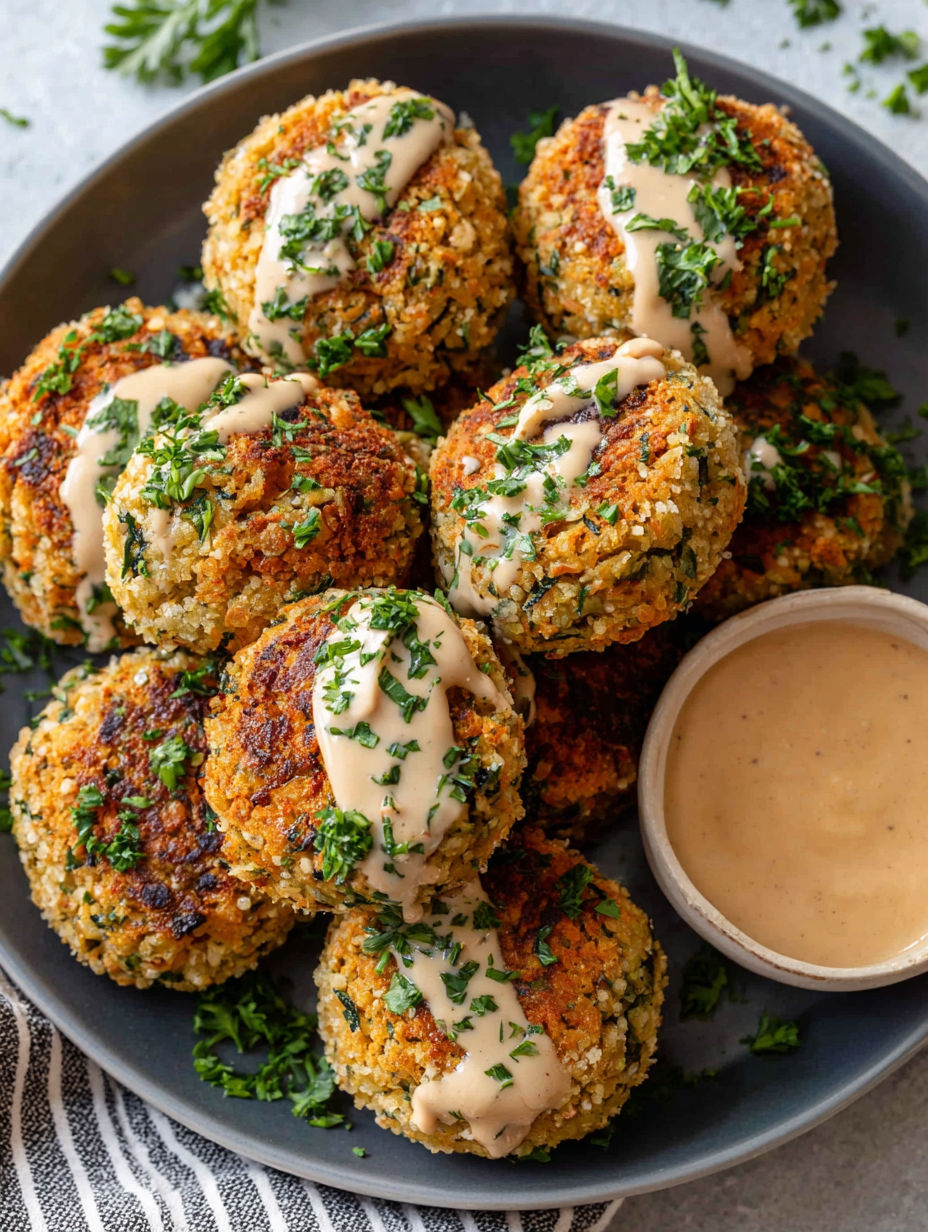 Bookmark
Bookmark
This baked falafel with tahini sauce is everything I crave in a meal—crispy on the edges, fluffy inside, and big on savory flavors with none of the deep frying. Chickpeas, herbs, and spices come together for a fresh bite that’s perfect tucked into a pita or enjoyed with a salad. Baking makes these falafel light but still loaded with golden crunch—the kind of weeknight dinner I never tire of.
The first time I baked falafel instead of frying them, I could not believe how close they came to the real thing—they became my go to option when friends come over for dinner.
Ingredients
- Canned chickpeas: Offer ease and a tender texture, rinse well for best flavor
- Fresh parsley and cilantro: Give classic green color and an herby kick, look for perky vibrant leaves
- Chopped onion: Adds subtle sweetness, dice finely for even mixing
- Minced garlic: Brings sharp depth, buy firm cloves with no green sprouts
- Ground cumin and coriander: Create that unmistakable Middle Eastern note, make sure they smell fragrant
- Fine salt and ground pepper: Season everything through, adjust to taste
- Olive oil: Ensures richness and moisture, use extra virgin for added flavor
- Fresh lemon juice: Brightens every bite, pick a lemon that feels heavy for its size
- Baking powder: Lifts the mixture for a fluffy center, make sure yours is fresh not expired
- Tahini sauce: Tahini delivers a creamy nutty base, stir before using for smoothness
- Lemon juice and water: Thin out the sauce and add tang, start with less water and add more as needed
- Minced garlic and salt (for tahini sauce): Round out the flavors
Instructions
- Prepare the Chickpeas:
- Drain and rinse one can of chickpeas thoroughly under cold water. This helps remove excess sodium and makes the final texture lighter. If using dried chickpeas, soak overnight and cook until they yield easily to a fork, let cool completely.
- Mix the Falafel Base:
- Add chickpeas, onion, garlic, parsley, cilantro, cumin, coriander, salt, pepper, olive oil, lemon juice, and baking powder to a food processor. Pulse until well blended but still a little coarse. Resist the urge to over process—a little texture is ideal for a traditional feel.
- Shape the Falafel:
- Use your hands to shape the mixture into balls or small patties, about one or two inches across. Place each one on a parchment lined baking sheet, leaving a bit of space between for air circulation. If the mixture is sticky, dampen your fingers lightly.
- Bake for Crispiness:
- Preheat your oven to four hundred degrees Fahrenheit. Arrange the tray in the center and bake for twenty to twenty five minutes. Carefully flip each falafel halfway through baking for even browning. For extra crunch, lightly brush or spray with olive oil before putting them in the oven.
- Make the Tahini Sauce:
- In a small bowl, whisk together tahini, fresh lemon juice, water, and minced garlic. Mix until creamy and smooth, adding a splash of water at a time if needed. Season with a pinch of salt for balance. The sauce should be pourable, not runny.
- Adjust and Serve:
- Taste your tahini sauce before serving—tweak with extra lemon, salt, or water. Place hot baked falafel on a serving platter, drizzle with sauce, and scatter some fresh herbs for color.

I love using just picked parsley from my garden in this recipe. The freshness truly makes the falafel sing. My kids always crowd around to steal the crispiest patties straight off the tray before they even cool down.
Storage Tips
Keep leftover falafel in an airtight container in the fridge for up to four days. Reheat falafel in a hot oven to regain crunch or eat cold over salads. The tahini sauce also tastes great as a spread or salad dressing.
Ingredient Substitutions
If parsley or cilantro are not your favorites, try using fresh dill, mint, or even a mix of soft green herbs. No tahini on hand? Use unsweetened cashew butter or sunflower seed butter as a close alternative for creaminess.
Serving Suggestions
Serve baked falafel tucked into pita bread with crunchy lettuce, tomatoes, and a spoonful of tangy tahini. Layer in a salad bowl with brown rice, pickled veggies, and extra sauce for a full meal. Add them to wraps with grilled eggplant and a swirl of yogurt for a fusion inspired lunch.
Cultural and Historical Context
Falafel is believed to have roots in Middle Eastern street food culture, often sold fresh from food carts with piping hot toppings. The baked version honors those flavors with an everyday healthy twist. It is a staple at family gatherings and holiday tables in many cultures across the region.
Seasonal Adaptations
In summer, add shaved cucumber and radishes for brightness. In winter, serve with warm roasted root vegetables for heartiness. Early spring is the perfect time to try with tender fresh herbs for the brightest green flavor.

With these easy steps, homemade baked falafel can become a favorite for busy nights or cozy gatherings. Enjoy golden falafel with creamy tahini every time.
Your Recipe Questions Answered
- → Can I use canned chickpeas for falafel?
Yes, canned chickpeas work well. Just drain and rinse before blending to remove excess sodium and moisture.
- → How can I make falafel extra crispy in the oven?
Lightly brush or spray falafel with olive oil before baking, and flip halfway through. Broil briefly if you prefer more crunch.
- → What substitutes can I use for tahini in the sauce?
Cashew butter or sunflower seed butter provide similar creamy texture and can be used if tahini is unavailable.
- → How should I store and reheat leftover falafel?
Store cooled falafel in an airtight container in the fridge. Reheat in the oven at 350°F for about 10 minutes to restore crispiness.
- → Is baked falafel suitable for gluten-free diets?
Yes, as long as all ingredients and toppings are gluten-free, baked falafel can be enjoyed without gluten concerns.
- → Can I freeze baked falafel?
Absolutely! Freeze cooled falafel on a tray, then store in a freezer bag for up to 3 months. Reheat in the oven for best texture.
